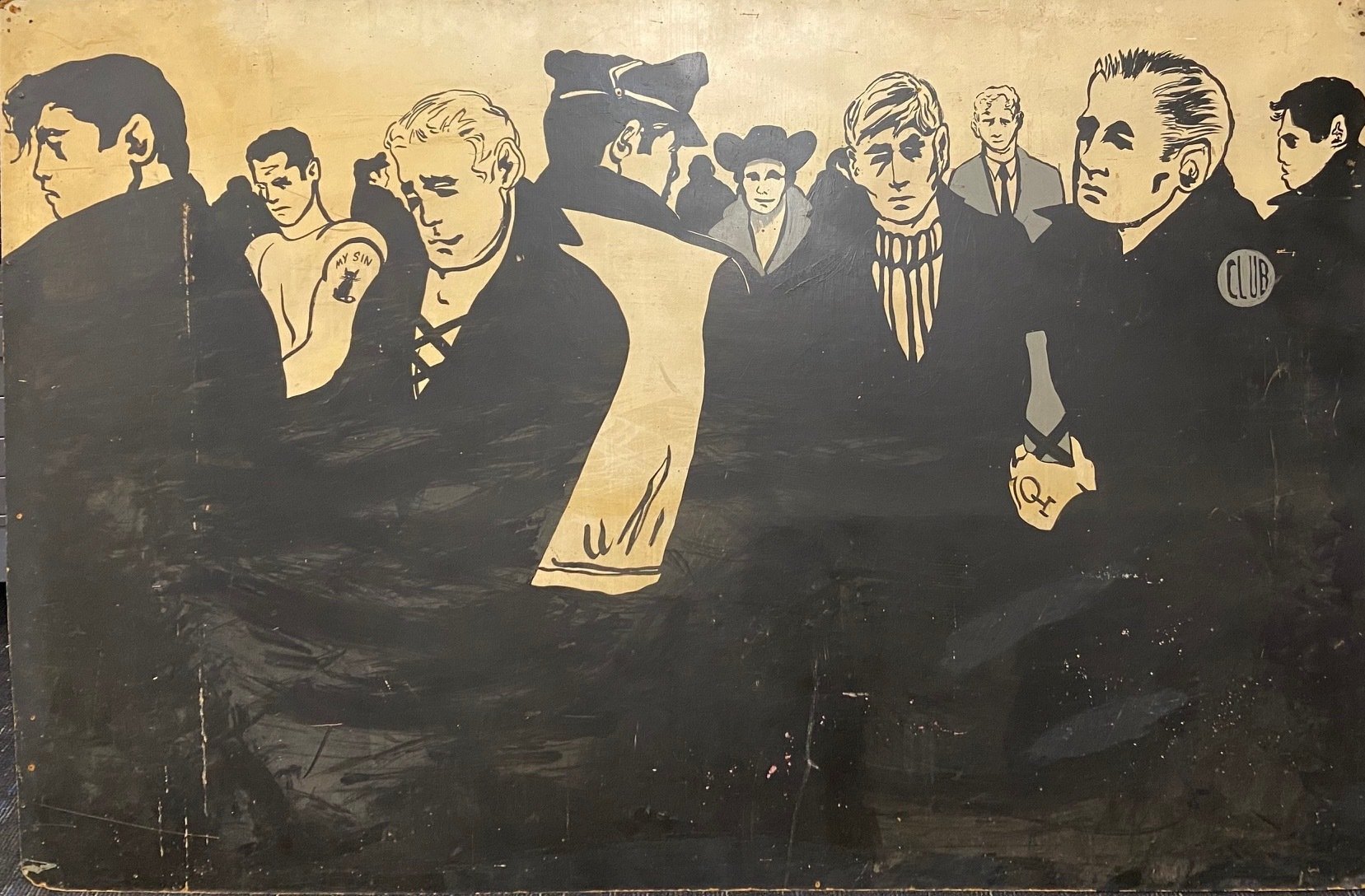The Artistry of Leather and Desire: Archives Acquire Tool Box Mural
Mural panel based on original 1962 mural at the Tool Box, Chuck Arnett (American, 1928–1988), paint on wooden board, ca. 1965; donated by Antonio Perales Fierro and Gerald Zientara, Art and Artifacts Collection (GLBT-ART), GLBT Historical Society.
The Artistry of Leather and Desire: Archives Acquire Tool Box Mural
Striking in its composition, this superb painted mural is yellowed with age and nicotine stains but still brims with sexual energy. The figures are seemingly drawn from a wide cross-section of mid-century society. A tattooed man in a sleeveless T-shirt fixes the viewer with a gaze suggestive of desire. A more bourgeois-looking fellow wears a striped turtleneck, while in the background a man in a full suit and tie looks on. To the left of center, a man wearing a leather cross-stitched shirt gazes at the rear end of a nearby patron, while in the very center a broad-shouldered man in what looks to be a leather motorcycle cap plays it coy, turning away.
The GLBT Historical Society is delighted to formally announce the acquisition of this remarkable work of art, which has joined the archives’ Art and Artifacts Collection. The panel, painted sometime in the mid-1960s, is the work of Chuck Arnett (1928–1988), a ballet dancer turned artist. Arnett painted it as a recreation of a mural he had originally executed on a glass storefront window that graced the wall of the Tool Box, a motorcycle and leather bar on the east corner of 4th and Harrison Streets in San Francisco’s South of Market (SoMa) neighborhood. Opened in 1961, this was one of the first gay leather/motorcycle bars in the city and became a pioneering leather establishment in this neighborhood that would come to be the epicenter of the city’s leather and kink community in the 1960s through the 1990s.
A Calling Card
The interior murals at the Tool Box, all painted by Arnett, were probably the establishment’s best-known calling card. Arnett painted one set of oversized murals along the south-facing, Harrison Street walls, and painted two mural panels on the glass storefront windows on the west-facing, 4th Street walls. One of the original glass murals was accidentally shattered when an angry janitor threw a broom across the room (the janitor later apologized to Arnett), prompting Arnett to paint several replicas on wood, including this one, probably painted in situ or from a photograph of the original. In contrast to the obscurity of the 4th Street panels, the Harrison Street murals became internationally known after photographs of the interior of the Tool Box were featured in a groundbreaking 1964 spread in Life Magazine entitled “Homosexuality in America.”
Though much loved and remarked-upon by patrons, Arnett’s remarkable Tool Box artwork was on display only a brief time; the Tool Box lost ground to other leather bars in the neighborhood and closed in 1971, and the building—with the Harrison Street murals still affixed to the southern wall—was torn down in 1975. Because the original glass panels were not shown in the Life spread nor in 1975 photographs of the building’s demolition, this panel provides valuable evidence of Arnett’s original artistic intent for his complete Tool Box decoration scheme. The panel was purchased and donated to the GLBT Historical Society in 2021. The donor acquired it from a San Francisco couple who had themselves purchased it at a garage sale some 30 years ago, and it had remained in their storage unit until last year.
Documenting Differences
We are still working with experts to determine when Arnett painted this panel and to fully document its provenance. Mike Caffee, an artist and former roommate of Arnett’s, and leather historian Gayle Rubin, have helped the GLBT Historical Society’s archives team with these efforts. In particular, Caffee identifies the leftmost figure as a portrait of biker and photographer Joe Winters. “[He was] drop-dead, movie-star handsome,” Caffee explains. “Chuck was smitten and included him many times in the murals.” Caffee also notes that rather than endowing the man in the white T-shirt with a tattoo of a black panther—a common motif used at the time to cover up older, unwanted tattoos—Arnett chose to give the tattooed figure a campy pussycat tattoo, while the text “My Sin” is borrowed from a women’s perfume by that name sold by Lanvin. Some interesting differences from the original glass panel include the fact that this mural includes men with blond hair, gray clothing, and a visible hand holding a bottle, none of which were present in the glass version.
While we are continuing to consult with experts in the field, we would love to hear more from the public about the Tool Box mural, especially if anyone has photographic evidence of the original glass panels. Our aim is to provide a complete picture of what the Tool Box looked like in its heyday!
Mark Sawchuk is communications manager at the GLBT Historical Society. He received his Ph.D. in European history at the University of California at Berkeley in 2011 and taught as a lecturer there for five years. He has worked with nonprofits in various capacities for much of his career.
Ramón Silvestre is museum registrar and curatorial specialist at the GLBT Historical Society. He is an expert in material culture studies. He previously was a Visiting Fellow at the Smithsonian’s National Museum of Natural History, and has published in many national and international professional journals, including The Smithsonian Institution Scholarly Press.

